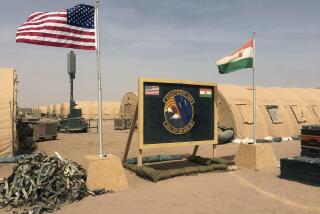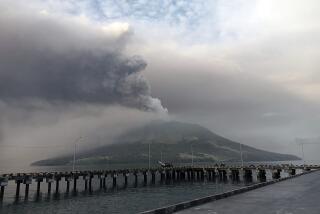Volcano Forces Air Force Cuts in Philippines
MANILA — As Mt. Pinatubo erupted violently again Thursday, the U.S. Air Force ordered the immediate evacuation of the bulk of its active-duty forces from the Philippines and stepped up the emergency evacuation of military dependents and civilians.
In a move that casts further doubt on the future of U.S. bases here, officials said that 4,500 of 7,000 Air Force personnel will leave this morning aboard a flotilla of warships led by two aircraft carriers, the Midway and Abraham Lincoln. The ships will carry them to Cebu in the central Philippines for military flights to Guam and back to the United States.
U.S. Embassy spokesman Stanley Schrager said the withdrawal is temporary “for the time being.” He added, “We hope we can come back, but we cannot speculate when.”
The decision to withdraw “non-essential” active-duty Air Force personnel came after preliminary assessment teams reported scores of buildings damaged or destroyed and widespread flooding at Clark Air Base, one of America’s largest overseas bases, after last Saturday’s massive eruption.
A fiery pyroclastic flow of super-hot gas and ash reached within 1,500 feet of a housing complex on Clark’s western perimeter, 8.6 miles from the volcano. Deep, cement-like ash now covers roads, runways and rooftops, and there is no electricity or water. Officials fear the base may be inoperable for a year or more because of dangerous levels of ash in the air.
U.S. officials say privately they also fear that more severe destruction is likely as growing monsoon rains threaten to set off devastating mudflows of deep volcanic debris down a network of river channels on the volcano’s steep slopes. One river flows directly onto Clark, while others lead to crowded villages in surrounding plains.
“This is a life-threatening situation,” said one official, who is monitoring the mountain. “You have only seen Act I. Act II will be worse. And it is coming.”
The death toll from last weekend’s eruption has risen to 268, Philippine officials said, and damage reports continue to grow. About a quarter million people were made homeless, and thousands of homes and buildings were destroyed.
Clark, headquarters of the 13th Air Force and a key transit point for Military Airlift Command flights, was blanketed with gray ash again Thursday afternoon when the worst series of eruptions since the weekend spewed a plume of steam nearly 10 miles high. As before, skies were reported pitch black at midafternoon. Earthquakes were felt in Manila, 60 miles to the south.
“It’s dumping pretty heavy at Clark,” said Navy spokesman Jerry Moore. “Kind of a duplicate of Saturday. Black again as midnight. Mudflows reaching the South China Sea. It’s a mean mountain.”
The carriers and other warships also will carry the last of 23,000 spouses, children and civilian employees of the Department of Defense from the heavily damaged Subic Bay Naval Base, 3,000 more than previously announced.
The evacuation will leave about 2,500 Air Force personnel in the Philippines. About 1,500 are working at Clark, though only 300 are staying there. The rest have been billeted at Subic since Clark was evacuated June 10 after the long-dormant mountain began erupting.
Moore said there were no current plans to evacuate the 7,000 sailors at Subic, despite extensive damage on the base. At least 122 warehouses and buildings collapsed, including part of the George Dewey High School, where the daughter of an Air Force sergeant and the daughter of a Filipina maid were crushed to death.
Intermittent water supplies have been returned to Subic, but base officials say full power will not be restored for at least six weeks.
U.S. Ambassador Nicholas Platt did not respond to repeated requests for an interview. He is to leave Manila today for Washington, where Senate hearings are scheduled Tuesday for his next posting as ambassador to Pakistan.
The latest evacuation is likely to further derail negotiations over the future of Clark and Subic. Bitter yearlong talks stalled in May over issues of compensation and duration. U.S. officials say the talks will not resume until they can assess the damage and cost of repairs.
“Clearly, we will take into consideration the damage that has been done to the facilities and what it will cost to repair them and assess how valuable those facilities are to us,” Defense Secretary Dick Cheney said Wednesday in Detroit.
Philippine Foreign Secretary Raul Manglapus said Wednesday that the eruption will not make Manila lower its demand for $825 million in annual compensation for the two bases. He told reporters that the destruction “does not in any way diminish the value of those bases.”
Clark Air Base may be unusable, however, as long as heavy ash remains in the air, endangering planes and clogging sensitive equipment. Evidence suggests that Mt. Pinatubo may continue emitting ash for six months to a year, said a U.S. official.
More to Read
Sign up for Essential California
The most important California stories and recommendations in your inbox every morning.
You may occasionally receive promotional content from the Los Angeles Times.











